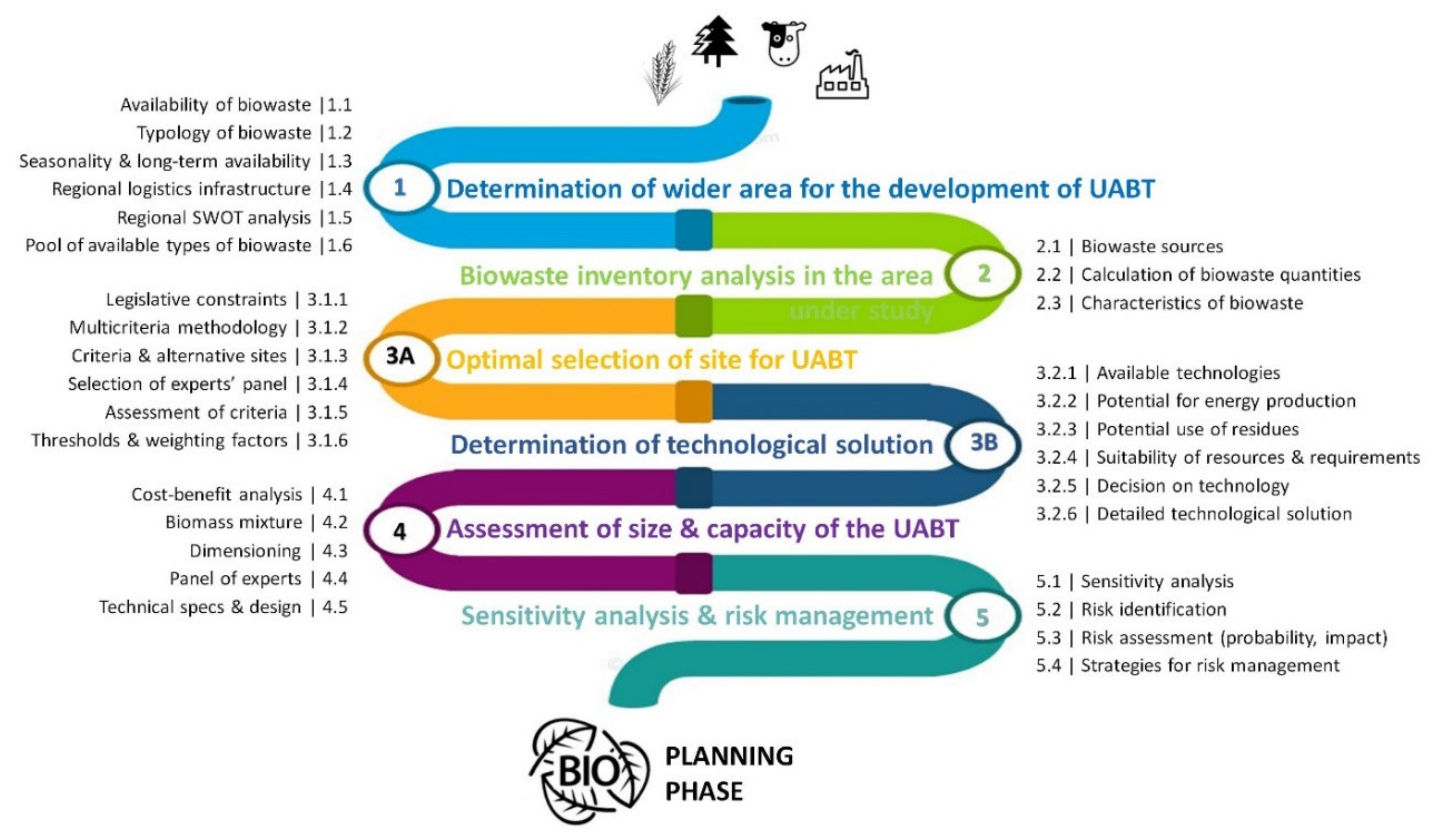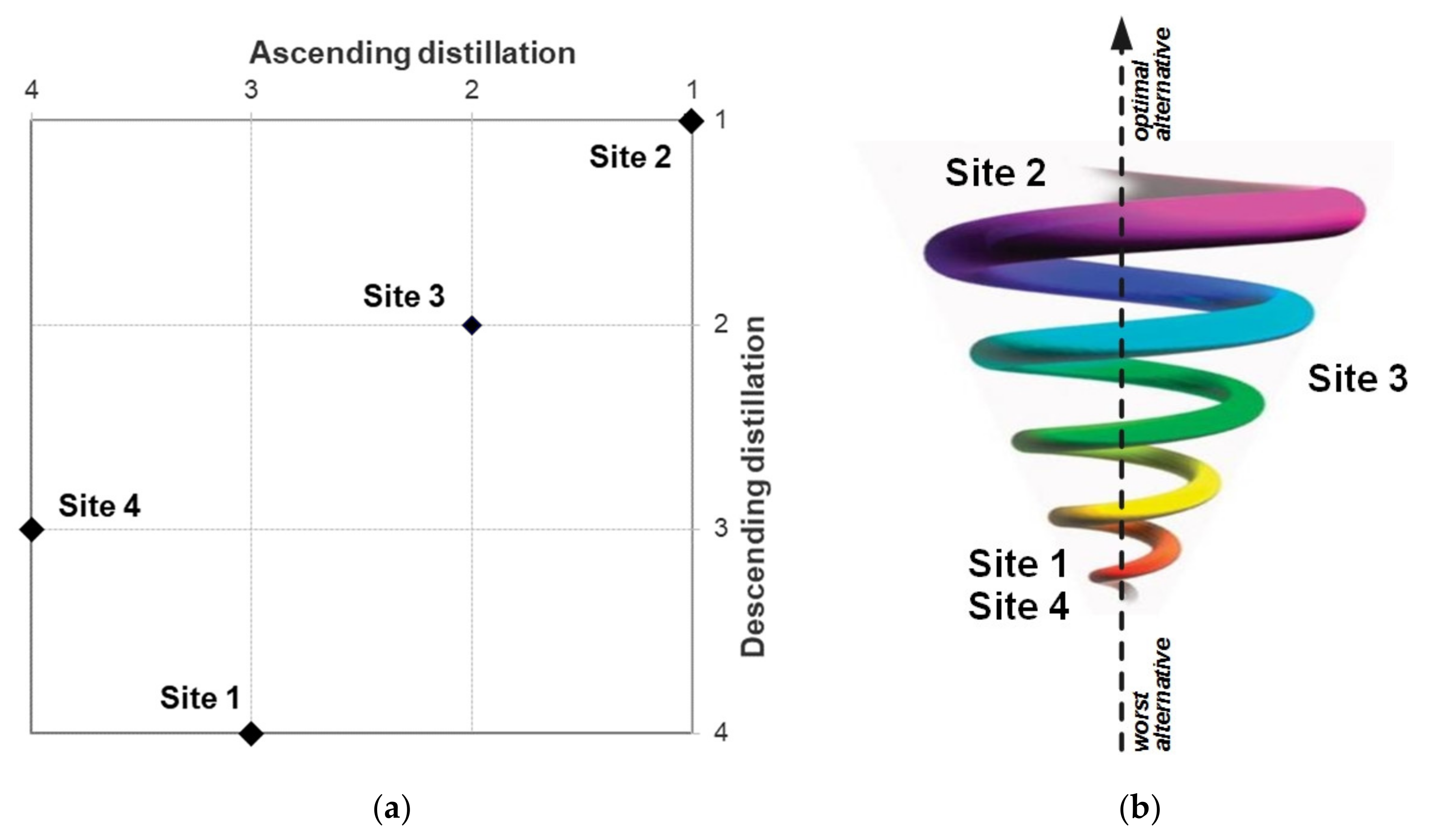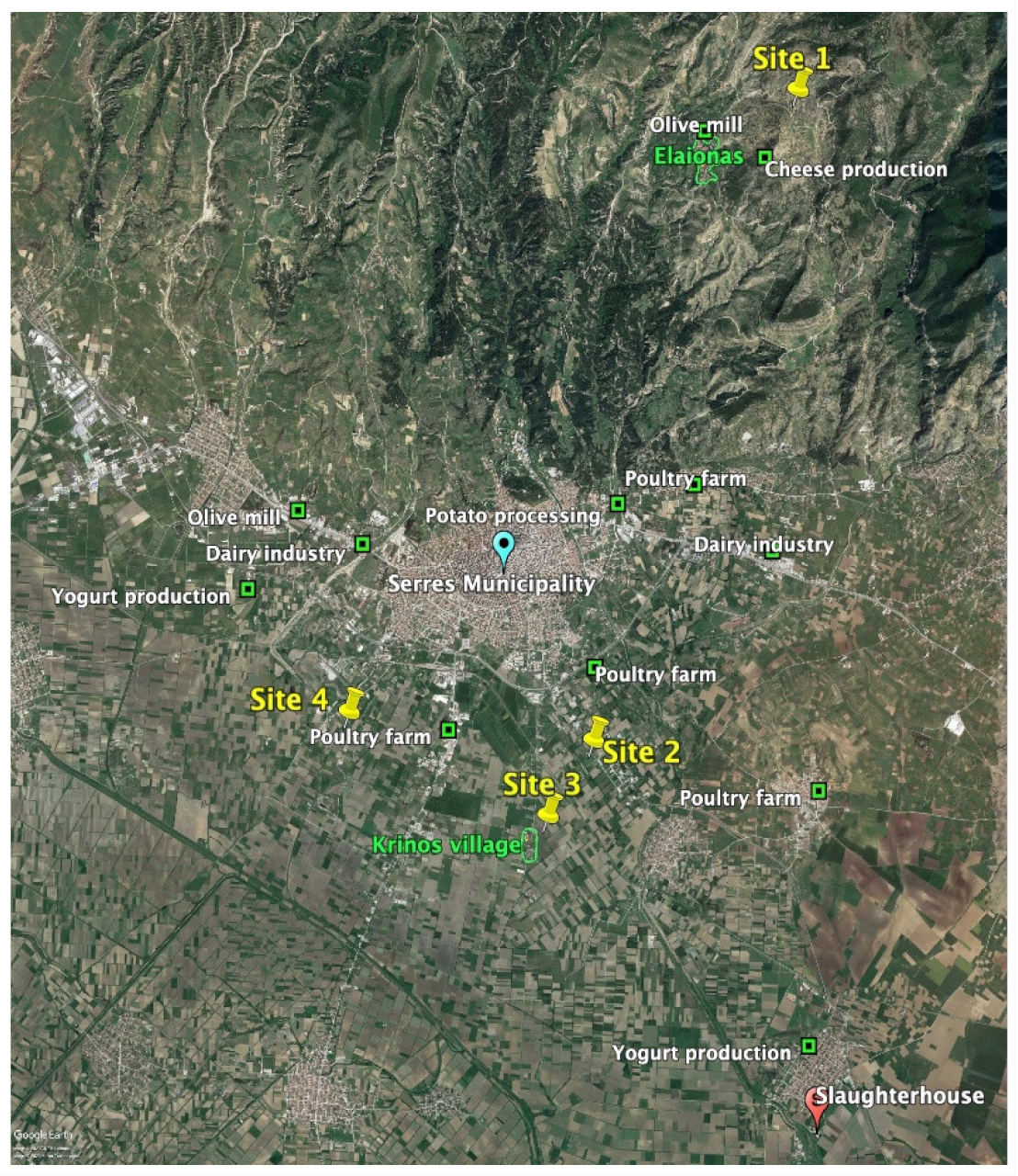Decision Support System to Implement Units of Alternative Biowaste Treatment for Producing Bioenergy and Boosting Local Bioeconomy
Abstract
1. Introduction
2. Methodology: Basic Structure and Components
2.1. Selection of Area and Inventory Analysis
2.2. Optimal Selection of the Site
- ▪
- When Vj (A1) − Vj (A2) ≤ qj, then no difference between A1 and A2 is identified for the specific criterion j, thus cj (A1, A2) = 0.
- ▪
- When Vj (A1) − Vj (A2) > pj, then A1 is strictly preferred to A2 for criterion j, thus cj (A1, A2) = 1.
- ▪
- When Vj (A1) − Vj (A2) ≤ pj, no discordance exists and therefore dj (A1, A2) = 0.
- ▪
- When Vj (A1) − Vj (A2) > vj, then dj (A1, A2) = 1.
2.3. Technology, Size, and Capacity of the UABT
3. Application of Methodology in the Region of Serres, Greece
3.1. The Area under Study
3.2. Alternative Sites and MCDA
3.3. Technology, Size, and Capacity of the UABT
4. Results and Discussion
4.1. Feedstock
4.2. Optimal Site
4.3. Technical Specifications
5. Conclusions
Author Contributions
Funding
Acknowledgments
Conflicts of Interest
References
- European Investment Bank. Circular Economy Guide—Supporting the Circular Transition. January 2019. Available online: https://www.eib.org/en/publications/the-eib-in-the-circular-economy-guide (accessed on 10 March 2020).
- Wautelet, T. The Concept of Circular Economy: Its Origins and Its Evolution; Positive ImpaKT: Windhof, Luxembourg, 2019. [Google Scholar]
- Sariatli, F. Linear economy versus circular economy: A Comparative and analyzer study for optimization of economy for sustainability. Visegr. J. Bioecon. Sustain. Dev. 2017, 1, 31–34. [Google Scholar] [CrossRef]
- Ellen MacArthur Foundation. Towards the Circular Economy: Economic Business Rationale for an Accelerated Transition; Ellen MacArthur Foundation: Cowes, UK, 2012. [Google Scholar]
- Michailidou, A.V.; Vlachokostas, C.; Moussiopoulos, N. A methodology to assess the overall environmental pressure attributed to tourism areas: A combined approach for typical all-sized hotels in Chalkidiki, Greece. Ecol. Indic. 2015, 50, 108–119. [Google Scholar] [CrossRef]
- European Commission. Directive 2009/28/EC on the Promotion of the Use of Energy from Renewable Sources; Official Journal of the European Union: Strasbourg, France, 2009. [Google Scholar]
- Mihai, F.C.; Ingrao, C. Assessment of biowaste losses through unsound waste management practices in rural areas and the role of home composting. J. Clean. Prod. 2018, 172, 1631–1638. [Google Scholar] [CrossRef]
- Bhatia, S.K.; Joo, H.S.; Yang, Y.H. Biowaste-to-bioenergy using biological methods—A mini-review. Energy Convers. Manag. 2018, 177, 640–660. [Google Scholar] [CrossRef]
- Thomsen, M.; Seghetta, M.; Mikkelsen, M.H.; Gyldenkærne, S.; Becker, T.; Caro, D.; Frederiksen, P. Comparative life cycle assessment of biowaste to resource management systems—A Danish case study. J. Clean. Prod. 2017, 142, 4050–4058. [Google Scholar] [CrossRef]
- Jensen, M.B.; Møller, J.; Scheutz, C. Comparison of the organic waste management systems in the Danish–German border region using life cycle assessment (LCA). Waste Manag. 2016, 49, 491–504. [Google Scholar] [CrossRef] [PubMed]
- Huttunen, S.; Manninen, K.; Leskinen, P. Combining biogas LCA reviews with stakeholder interviews to analyse life cycle impacts at a practical level. J. Clean. Prod. 2014, 80, 5–16. [Google Scholar] [CrossRef]
- Iakovou, E.; Vlachos, D.; Achillas, C.; Anastasiadis, F. Design of sustainable supply chains for the agrifood sector: A holistic research framework. Agric. Eng. Int. CIGR J. 2014, 16, 1–10. [Google Scholar]
- Delgado, M.; López, A.; Cuartas, M.; Rico, C.; Lobo, A. A decision support tool for planning biowaste management systems. J. Clean. Prod. 2020, 242, 118460. [Google Scholar] [CrossRef]
- Vea, E.B.; Romeo, D.; Thomsen, M. Biowaste valorisation in a future circular bioeconomy. Procedia CIRP 2018, 69, 591–596. [Google Scholar] [CrossRef]
- Banias, G.; Achillas, C.; Vlachokostas, C.; Moussiopoulos, N.; Stefanou, M. Environmental impacts in the life cycle of olive oil: A literature review. J. Sci. Food Agric. 2017, 97, 1686–1697. [Google Scholar] [CrossRef] [PubMed]
- Ross, T.; Soland, R. A multicriteria approach to the location of public facilities. Eur. J. Oper. Res. 1980, 4, 307–321. [Google Scholar] [CrossRef]
- Vučijak, B.; Kurtagić, S.M.; Silajdžić, I. Multicriteria decision making in selecting best solid waste management scenario: A municipal case study from Bosnia and Herzegovina. J. Clean. Prod. 2016, 130, 166–174. [Google Scholar] [CrossRef]
- Rezaei, J. A systematic review of multi-criteria decision-making applications in reverse logistics. Transp. Res. Procedia 2015, 10, 766–776. [Google Scholar] [CrossRef]
- Soltani, A.; Hewage, K.; Reza, B.; Sadiq, R. Multiple stakeholders in multi-criteria decision-making in the context of Municipal Solid Waste Management: A review. Waste Manag. 2015, 35, 318–328. [Google Scholar] [CrossRef] [PubMed]
- Achillas, C.; Moussiopoulos, N.; Karagiannidis, A.; Banias, G.; Perkoulidis, G. Use of multi-criteria decision analysis to tackle waste management problems: A literature review. Waste Manag. Res. 2013, 31, 115–129. [Google Scholar] [CrossRef]
- Simões Gomes, C.; Nunes, K.; Xavier, L.H.; Cardoso, R.; Valle, R. Multicriteria decision making applied to waste recycling in Brazil. Omega 2008, 36, 395–404. [Google Scholar] [CrossRef]
- Vego, G.; Kučar-Dragičević, S.; Koprivanac, N. Application of multi-criteria decision-making on strategic municipal solid waste management in Dalmatia, Croatia. Waste Manag. 2008, 28, 2192–2201. [Google Scholar] [CrossRef]
- Queiruga, D.; Walther, G.; Gonzalez-Benito, J.; Spengler, T. Evaluation of sites for the location of WEEE recycling plants in Spain. Waste Manag. 2008, 28, 181–190. [Google Scholar] [CrossRef]
- Michailidou, A.V.; Vlachokostas, C.; Moussiopoulos, N.; Maleka, D. Life Cycle Thinking used for assessing the environmental impacts of tourism activity for a Greek tourism destination. J. Clean. Prod. 2016, 111, 499–510. [Google Scholar] [CrossRef]
- Achillas, C.; Vlachokostas, C.; Moussiopoulos, N.; Banias, G.; Kafetzopoulos, G.; Karagiannidis, A. Social acceptance for the development of a Waste-to-Energy plant in an urban area: Application for Thessaloniki, Greece. Resour. Conserv. Recycl. 2011, 55, 857–863. [Google Scholar] [CrossRef]
- Morrissey, A.J.; Browne, J. Waste management models and their application to sustainable waste management. Waste Manag. 2004, 24, 297–308. [Google Scholar] [CrossRef] [PubMed]
- Taelman, S.; Sanjuan-Delmás, D.; Tonini, D.; Dewulf, J. An operational framework for sustainability assessment including local to global impacts: Focus on waste management systems. Resour. Conserv. Recycl. 2019, 2, 100005. [Google Scholar] [CrossRef]
- Soukopová, J.; Vaceková, G.; Klimovský, D. Local waste management in the Czech Republic: Limits and merits of public-private partnership and contracting out. Util. Policy 2017, 48, 201–209. [Google Scholar] [CrossRef]
- European Commission. Directive 2008/98/EC on Waste (Waste Framework Directive); Official Journal of the European Union: Strasbourg, France, 2008. [Google Scholar]
- Achillas, C.; Vlachokostas, C.; Moussiopoulos, N.; Perkoulidis, G.; Banias, G.; Mastropavlos, M. Electronic waste management cost: A scenario-based analysis for Greece (2011). Waste Manag. Res. 2011, 29, 963–972. [Google Scholar] [CrossRef] [PubMed]
- Le Hesran, C.; Ladier, A.L.; Botta-Genoulaz, V.; Laforest, V. Operations scheduling for waste minimization: A review. J. Clean. Prod. 2019, 206, 211–226. [Google Scholar] [CrossRef]
- Silva, S.; Alçada-Almeida, L.; Dias, L. Biogas plants site selection integrating Multicriteria Decision Aid methods and GIS techniques: A case study in a Portuguese region. Biomass Bioenergy 2014, 71, 58–68. [Google Scholar] [CrossRef]
- Banias, G.; Achillas, C.; Vlachokostas, C.; Moussiopoulos, N.; Tarsenis, S. Assessing multiple criteria for the optimal location of a construction and demolition waste management facility. Build. Environ. 2010, 45, 2317–2326. [Google Scholar] [CrossRef]
- Iakovou, E.; Moussiopoulos, N.; Xanthopoulos, A.; Achillas, C.; Michailidis, N.; Chatzipanagioti, M.; Koroneos, C.; Bouzakis, K.D.; Kikis, V. Multicriteria Matrix: A methodology for end-of-life management. Resour. Conserv. Recycl. 2009, 53, 329–339. [Google Scholar] [CrossRef]
- Rousis, K.; Moustakas, K.; Malamis, S.; Papadopoulos, A.; Loizidou, M. Multi-criteria analysis for the determination of the best WEEE management scenario in Cyprus. Waste Manag. 2008, 28, 1941–1954. [Google Scholar] [CrossRef]
- Hokkanen, J.; Salminen, P. Choosing a solid waste management system using multicriteria decision analysis. Eur. J. Oper. Res. 1997, 98, 19–36. [Google Scholar] [CrossRef]
- Chatterjee, P.; Yazdani, M.; Chakraborty, S.; Panchal, D.; Bhattacharyya, S. (Eds.) Advanced Multi-Criteria Decision Making for Addressing Complex Sustainability Issues. In Advances in Environmental Engineering and Green Technologies, 1st ed.; IGI Global: Hershey, PA, USA, 2019. [Google Scholar]
- Ishizaka, A.; Nemery, P. Multi-Criteria Decision Analysis: Methods and Software; Wiley: Hoboken, NJ, USA, 2013. [Google Scholar]
- Al-Shemmeri, T.; Al-Kloub, B.; Pearman, A. Model choice in multicriteria decision aid. Eur. J. Oper. Res. 1997, 97, 550–560. [Google Scholar] [CrossRef]
- Roy, B. Electre III: Algorithme de classement base sur une representation floue des preferences en presence de criteres multiples. Cah. CERO 1978, 20, 3–24. [Google Scholar]
- Roy, B.; Bouyssou, D. Aide Multicritere a la Decision: Methods et Cas; Economica: Paris, France, 1993. [Google Scholar]
- Spyridi, D.; Vlachokostas, C.; Michailidou, A.V.; Sioutas, C.; Moussiopoulos, N. Strategic planning for climate change mitigation and adaptation: The case of Greece. Int. J. Clim. Chang. Strateg. Manag. 2015, 7, 272–289. [Google Scholar] [CrossRef]
- Vlachokostas, C.; Michailidou, A.V.; Matziris, E.; Achillas, C.; Moussiopoulos, N. A multiple criteria decision-making approach to put forward tree species in urban environment. Urban Clim. 2014, 10, 105–118. [Google Scholar] [CrossRef]
- Rogers, M.; Bruen, M. Choosing realistic values of indifference, preference and veto thresholds for use with environmental criteria within ELECTRE. Eur. J. Oper. Res. 1998, 107, 542–551. [Google Scholar] [CrossRef]
- Roussat, N.; Dujet, C.; Mehu, J. Choosing a sustainable demolition waste management strategy using multicriteria decision analysis. Waste Manag. 2009, 29, 2–20. [Google Scholar] [CrossRef]
- Vlachokostas, C.; Achillas, C.; Moussiopoulos, N.; Banias, G. Multicriteria methodological approach to manage urban air pollution. Atmos. Environ. 2011, 45, 4160–4169. [Google Scholar] [CrossRef]
- Republic of Greece. Law 4513/2018 on Energy Communities. In Official Government Gazette 9/A’/23.01.2018; Hellenic Republic: Athens, Greece, 2018. [Google Scholar]
- ZEFFIROS Project. Official Website. 2020. Available online: https://www.zeffirosproject.eu (accessed on 14 March 2020).
- Michailidou, A.V.; Vlachokostas, C.; Moussiopoulos, N. Interactions between climate change and the tourism sector: Multiple-criteria decision analysis to assess mitigation and adaptation options in tourism areas. Tour. Manag. 2016, 55, 1–12. [Google Scholar] [CrossRef]
- Haralambopoulos, D.; Polatidis, H. Renewable energy projects: Structuring a multi-criteria group decision-making framework. Renew. Energy 2003, 28, 961–973. [Google Scholar] [CrossRef]
- Kourmpanis, B.; Papadopoulos, A.; Moustakas, K.; Kourmoussis, F.; Stylianou, M.; Loizidou, M. An integrated approach for the management of demolition waste in Cyprus. Waste Manag. Res. 2008, 26, 573–581. [Google Scholar] [CrossRef] [PubMed]
- Kumar, A.; Samadder, S. Performance evaluation of anaerobic digestion technology for energy recovery from organic fraction of municipal solid waste: A review. Energy 2020, 197, 117253. [Google Scholar] [CrossRef]
- Srisowmeya, G.; Chakravarthy, M.; Nandhini Devi, G. Critical considerations in two-stage anaerobic digestion of food waste—A review. Renew. Sustain. Energy Rev. 2020, 119, 109587. [Google Scholar] [CrossRef]
- Wainaina, S.; Awasthi, M.K.; Sarsaiya, S.; Chen, H.; Singh, E.; Kumar, A.; Ravindran, B.; Awasthi, S.K.; Liu, T.; Duan, Y.; et al. Resource recovery and circular economy from organic solid waste using aerobic and anaerobic digestion technologies. Bioresour. Technol. 2020, 30, 122778. [Google Scholar] [CrossRef] [PubMed]
- Pramanik, S.K.; Suja, F.B.; Zain, S.; Pramanik, B.K. The anaerobic digestion process of biogas production from food waste: Prospects and constraints. Bioresour. Technol. Rep. 2019, 8, 100310. [Google Scholar] [CrossRef]
- Mc Cabe, B.; Schmidt, T. Integrated Biogas Systems—Local Applications of Anaerobic Digestion towards Integrated Sustainable Solutions; Murphy, J.D., Ed.; International Energy Agency: Cork, Ireland, 2018. [Google Scholar]
- Al Seadi, T.; Stupak, I.; Smith, C.T. Governance of Environmental Sustainability of Manure-Based Centralised Biogas Production in Denmark; Murphy, J.D., Ed.; IEA Bioenergy: Cork, Ireland, 2018. [Google Scholar]
- Holm-Nielsen, J.B.; Halberg, N.; Hutingford, S.; Al Seadi, T. Joint biogas plant. Agricultural advantages—Circulation of N, P and K. In Report made for the Danish Energy Agency, 2nd ed.; Danish Energy Agency: Copenhagen, Denmark, 1997. [Google Scholar]
- Fagerström, A.; Al Seadi, T.; Rasi, S.; Briseid, T. The Role of Anaerobic Digestion and Biogas in the Circular Economy; Murphy, J.D., Ed.; IEA Bioenergy: Cork, Ireland, 2018. [Google Scholar]


| Location of Sites | Site | Description |
|---|---|---|
 | Site 1 | Located in a public area in Eleonas in the Forage Park. Access is through a forest road network with great difficulty. Road and water supply projects are required. Distance from the city is about 10 km and 23 km from the Slaughterhouse. |
| Site 2 | Located in a public area in the Farm of Serres, 2 km from Serres and 7 km from the Slaughterhouse. Access is easy via the “Serres-Neos Skopos” provincial road. A few meters from the site, there is a municipal vegetable garden and a greenhouse. | |
| Site 3 | Located in a municipal area in the Farm of Serres, 0.5 km from Krinos village and 8 km from the Slaughterhouse (via dust road, or 12 km via municipal roads). | |
| Site 4 | Located in a public area in the Farm of Serres, near the Omonia Sports Park. The site is 13.5 km from the Slaughterhouse via municipal roads and 0.5 km from the city. |
| Criterion | Site 1 (1–10) | Site 2 (1–10) | Site 3 (1–10) | Site 4 (1–10) | Weights (%) | pi | qi |
|---|---|---|---|---|---|---|---|
| Cr1 - Distance from biowaste source | 1.46 | 8.92 | 6.92 | 5.69 | 15 | 1.87 | 0.56 |
| Cr2 - Accessibility of site | 1.69 | 9.62 | 6.31 | 6.77 | 14 | 1.98 | 0.59 |
| Cr3 - Distance from units for energy consumption | 2.00 | 9.46 | 7.54 | 7.15 | 12 | 1.87 | 0.56 |
| Cr4 - Distance from farms for compost use | 3.85 | 9.23 | 8.31 | 7.69 | 8 | 1.35 | 0.40 |
| Cr5 - Value of land | 2.85 | 9.15 | 7.62 | 7.23 | 12 | 1.58 | 0.47 |
| Cr6 - Impacts on local populations | 9.23 | 7.31 | 2.62 | 2.00 | 10 | 1.81 | 0.54 |
| Cr7 - Impacts on local ecosystems | 3.85 | 8.00 | 5.92 | 5.77 | 10 | 1.04 | 0.31 |
| Cr8 - Aesthetic degradation | 4.85 | 8.46 | 4.69 | 3.23 | 6 | 1.31 | 0.39 |
| Cr9 - Increase in road traffic due to UATB | 3.08 | 7.08 | 2.85 | 3.46 | 5 | 1.06 | 0.32 |
| Cr10 - Social acceptance | 8.69 | 8.46 | 2.69 | 2.23 | 8 | 1.62 | 0.48 |
| Raw Material | Supply Quantity (Tons/Day) | Days of Supply (Days/Year) | Overall Quantity (Tons/Year) | EWL Code |
|---|---|---|---|---|
| Dairy cow slurry manure | 6.27 | 200 | 1254 | 02 01 06 |
| Cow manure | 5.91 | 200 | 1183 | 02 01 06 |
| Calf manure | 0.51 | 200 | 102 | 02 01 06 |
| Cattle manure | 0.73 | 200 | 146 | 02 01 06 |
| Poultry manure | 0.32 | 104 | 33 | 02 01 06 |
| Cheese whey | 1.78 | 156 | 278 | 02 05 01 |
| Rotten potato pulp | 1.00 | 32 | 32 | 02 01 03 |
| Olive mill waste | 2.37 | 32 | 76 | 02 03 01 |
| Slaughterhouse waste - Intestine content | 1.44 | 104 | 150 | 02 02 01 |
| Slaughterhouse waste - Stomachs and fat | 0.25 | 52 | 13 | 02 02 02 |
| Slaughterhouse waste - Blood | 0.35 | 52 | 18 | 02 02 02 |
| TOTAL | 3285 |
| Thresholds | Scenario | ||||||
|---|---|---|---|---|---|---|---|
| Baseline | A | B | C | D | E | F | |
| pi | pi | 1.25 × pi | 1.50 × pi | 0.75 × pi | 0.50 × pi | pi | 0.50 × pi |
| qi | 0.3 × pi | 0.375 × pi | 0.45 × pi | 0.225 × pi | 0.15 × pi | 0 | 0.30 × pi |
| Variation | - | +25% | +50% | −25% | −50% | pi = pi |qi = 0 | pi = ½ pi |qi = 0 |
| Ranking | 1st: Site 2 2nd: Site 3 3rd: Site 1,4 | 1st: Site 2 2nd: Site 3,4 4th: Site 1 | 1st: Site 2 2nd: Site 3,4 4th: Site 1 | 1st: Site 2 2nd: Site 3 3rd: Site 1,4 | 1st: Site 2 2nd: Site 3 3rd: Site 1,4 | 1st: Site 2 2nd: Site 3 3rd: Site 1,4 | 1st: Site 2 2nd: Site 3 3rd: Site 1,4 |
© 2020 by the authors. Licensee MDPI, Basel, Switzerland. This article is an open access article distributed under the terms and conditions of the Creative Commons Attribution (CC BY) license (http://creativecommons.org/licenses/by/4.0/).
Share and Cite
Vlachokostas, C.; Achillas, C.; Agnantiaris, I.; Michailidou, A.V.; Pallas, C.; Feleki, E.; Moussiopoulos, N. Decision Support System to Implement Units of Alternative Biowaste Treatment for Producing Bioenergy and Boosting Local Bioeconomy. Energies 2020, 13, 2306. https://doi.org/10.3390/en13092306
Vlachokostas C, Achillas C, Agnantiaris I, Michailidou AV, Pallas C, Feleki E, Moussiopoulos N. Decision Support System to Implement Units of Alternative Biowaste Treatment for Producing Bioenergy and Boosting Local Bioeconomy. Energies. 2020; 13(9):2306. https://doi.org/10.3390/en13092306
Chicago/Turabian StyleVlachokostas, Christos, Charisios Achillas, Ioannis Agnantiaris, Alexandra V. Michailidou, Christos Pallas, Eleni Feleki, and Nicolas Moussiopoulos. 2020. "Decision Support System to Implement Units of Alternative Biowaste Treatment for Producing Bioenergy and Boosting Local Bioeconomy" Energies 13, no. 9: 2306. https://doi.org/10.3390/en13092306
APA StyleVlachokostas, C., Achillas, C., Agnantiaris, I., Michailidou, A. V., Pallas, C., Feleki, E., & Moussiopoulos, N. (2020). Decision Support System to Implement Units of Alternative Biowaste Treatment for Producing Bioenergy and Boosting Local Bioeconomy. Energies, 13(9), 2306. https://doi.org/10.3390/en13092306









